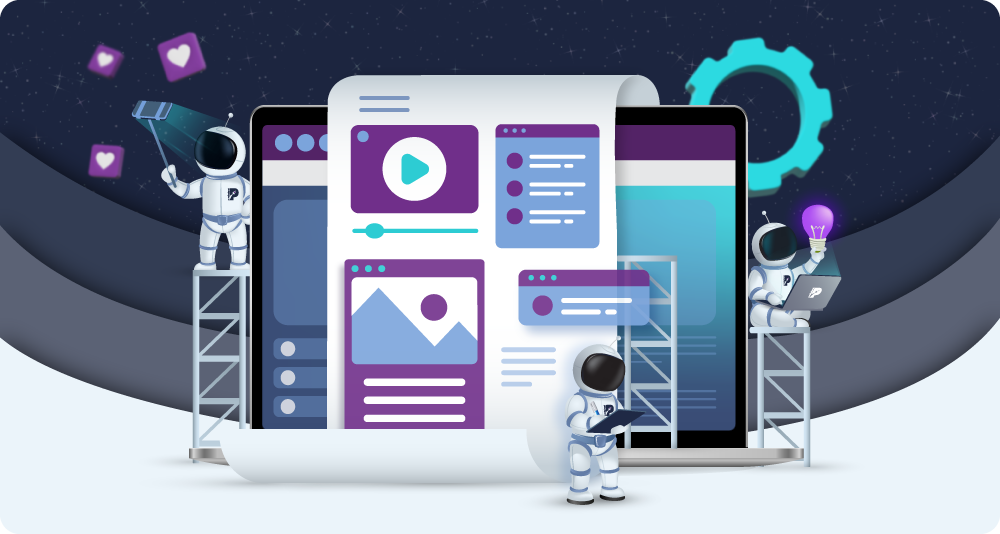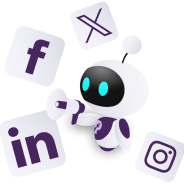

The Evolution of Content Marketing: From Blog Posts to Podcasts and Beyond
When push comes to shove, marketers and online businesses just want to keep consumers engaged. It is a constantly changing challenge – one which many have succeeded in.
The task of engaging leads and internet users is dynamic for several reasons. However, the changes in technology and persistent competition are the most influential.
If you want to understand the heart of content marketing, you have to trace its roots back to the 1990s. Since then, there have been countless trends that have caused businesses and marketing teams to change tact. There have been huge industry changes that forced teams to adapt and rise to new challenges. Consumer standards have increased, causing platforms to offer new opportunities for engagement.
Over the years, new types of content have emerged – podcasts, webinars, vlogs, blogs, and more!
To understand how content marketing has evolved into what it is today, we need to trace things back to when the internet was still in its infancy. Looking at several key events, we can gain a better understanding of what internet users really want and what the future may hold.
Let’s take a step into the past and look at how content marketing started.
Timeline of key events in the evolution of content marketing
1994 – The first banner ad
The first banner ad appeared on HotWired.com for AT&T in 1994. Though it was a simple message, it had a click-through rate of 44%. This monumental moment in content marketing set the stage, demonstrating how online messaging could “transport people through space and time via the Internet.” With a CTR as high as that, clearly, users were excited to be part of a conversation with the rest of the internet.
1995 – Amazon welcomed customer reviews
The conversation continued in the following year, with Amazon allowing customers to leave public reviews. Just a year after the business’s creation, people thought Bezos had made a radical decision – users could say anything they wanted.
However, this customer review system revolutionised how people shop online and interact with the internet overall. It became one huge conversation – perhaps some of the first user-generated content ever.
Perhaps this also welcomed an element of transparency from businesses, which would later be increased by social media.
1996 – The first webinars
Through Microsoft’s NetMeeting, the first public web conferences took place in 1996. However, the term “webinar” wouldn’t be used until 1998.
In the next twenty years, webinar and video meeting platforms would continue to emerge: GoToWebinar, ClickMeeting, Google Meet, Microsoft Teams, Zoom, etc.
This very first Internet conference revealed the consumer’s desire for interconnectedness and the understanding of the Internet as a vehicle for sharing information.
1998 – The birth of Google
The birth of Google in 1998 marked a seminal moment in the digital landscape.
With the PageRank algorithm, the way information was catalogued and discovered was changed completely. With Google emphasising the importance of relevance, it wasn’t long before businesses began to craft content with the purpose of serving customer needs, increasing online visibility, and aligning with Google’s algorithm.
This shift laid the groundwork for what would become the SEO industry, where the pursuit of search engine rankings would be a battleground for brand exposure and consumer engagement. But, more about that later.
1999 – RSS feeds
Although it wouldn’t be adopted for a few years, the advent of RSS in 1999 was another huge moment for the sharing of content.
RSS feeds automated the distribution of new content, whereby users could know instantly when new information had been added to websites. RSS allowed users to subscribe to content and see all of it in a news aggregator feed.
Though this phenomenon was, in many ways, replaced by social media, it’s clear from consumers’ use of RSS that they liked being connected with others and the instant sharing of information.
2000 – The launch of AdWords
In 2000, Google launched AdWords (now Google Ads). It allowed advertisers to display their ads in the SERPs and by 2002, they were paying per click.
This new technology allowed content marketers to reach targeted audiences and users became accustomed to their search engines being a space for commerce as well as news and socialising.
2003 – The launch of WordPress
The launch of WordPress in 2003 made it easy for anyone to create content and publish it online. This meant that the creation of blogs, and other forms of content, was democratised. It was easy and accessible, inviting individuals to contribute.
Though this led to an explosion in the quantity of content on the internet, it created niche spaces for different users to identify with and enjoy. This need for niche content would increase with the introduction of podcasts and vlogs in just the next couple of years.
2004 – The first podcasts
In his 2004 Guardian article, Ben Hammersley describes the new phenomenon of podcasts: “downloadable as you wish”, illustrating how this emerging content type was highly adaptable to the consumer. Similarly to the trend of niche blogs, there were podcasts for everyone: news, comedy, and music to name a few.
The year after, Apple released iTunes 4.9 which included support for podcasts, vastly increasing their reach.
2004 – The launch of GoToWebinar
In 2004, LogMeIn (now GoTo) released GoToWebinar, a dedicated platform for hosting webinars, making it easier for businesses to conduct online seminars with large audiences.
This innovation allowed people to attend interactive sessions from anywhere in the world, enabling professional development and education without the constraints of location.
The convenience and accessibility of webinars soon set the standard for personal and professional communication across the internet and paved the way for content marketing to become immersive and interactive.
2005 – The launch of YouTube
The creation of YouTube in 2005 provided a platform for video content that would become one of the most powerful content marketing channels in the world.
Not only that, but the launch of YouTube gave rise to a standard of interactivity since users could engage with videos by liking, commenting, and sharing.
2005 – HubSpot coins the term “inbound marketing”
HubSpot coined the term “inbound marketing” in 2005, advocating for providing customers with relevant and helpful content in order to forge long-term B2C relationships.
In many ways, this was a counter-cultural move away from TV ads and PPC, but clearly, it was a shift that stuck. We can see that consumers did indeed enjoy relevant and helpful content from businesses, as the internet landscape changed significantly from this point in time.
2007 – The birth of the iPhone
The iPhone and subsequent smartphones made on-the-go content consumption common. As a result, marketers were forced to create mobile strategies that shared quick and attention-grabbing content.
2007 – Facebook business pages
In 2007, Facebook introduced business pages. These allowed companies to create pages to connect with their audiences. This addition marked social media as a platform for content marketing, as consumers could see company content in their feeds and speak to them in a public forum.
Ultimately, this gave businesses a new way to engage with audiences directly and opened up various issues around transparency, engagement, and interactivity.
2011 – Google Panda
Google’s 2011 Panda update (and their subsequent Penguin update in 2012) drastically changed the SEO landscape. These updates were created with the aim of lowering the rank of low-quality sites and rewarding higher-quality sites with top positions in the SERPs.
By penalising low-quality content, companies were pushed to focus on providing content that was relevant, helpful, and genuine. As a result, content marketing had to appeal to customers in a real way, rather than keyword stuffing.
2011 – BuzzFeed becomes a sensation
In 2011, BuzzFeed was found to be the 13th most popular blog in the world. The quirky news platform was loved for its quizzes, calculators, and trendy YouTube content – showing the consumer’s engagement in interactive content.
Looking back at BuzzFeed from today’s lens, we can see how internet users looked to the web for fun, comedy, and similar social groups. In addition, it was enjoyable when they could respond and be involved in the content itself.
2012 – Facebook buys Instagram
For approximately $1 billion, Facebook bought Instagram in 2012. This marked a pivotal moment in the history of social media, as many believed the acquisition would lead to Instagram becoming more monetised for commerce and influencer accounts.
Zuckerberg said they would continue to deliver the “best experiences” for users. However, the monetisation of Instagram became apparent in the following year. In 2013, Instagram introduced sponsored posts. This made it much easier for brands to promote content and collaborate with influencers.
As a result, content marketing began to include influencer collaborations and native product promotion.
2013 – Google Hangouts On Air
In 2013, the webinar industry was changed by Google’s Hangouts On Air.
This service allowed users to broadcast live sessions, lectures, and conferences to a large audience for free. As a result, the webinar space was able to reach big audiences.
With the popularity of YouTube, Facebook, and Instagram already in place, webinars were much more niche and connected unique realms of the internet together.
2013 – Google Hummingbird
Also in 2013, Google released its Hummingbird update. Hummingbird changed the algorithm to try and understand user intent better, looking for contextual meanings in queries.
As a result, SEO and content marketers had to focus much more on natural language and less on shorter keywords.
2013 – Snapchat Stories
2013 saw further changes with Snapchat’s Stories. This social app started the trend which would later be adopted by other platforms and become crucial to content marketing strategies.
Stories were a significant change for content marketers because they offered a completely new way of engaging with audiences. Disappearing after 24 hours, stories had to be timely, relevant, and even interactive.
2013 – The launch of Vine
The launch of Vine in 2013 was the beginning of short video content. The platform for six-second looping videos became immensely popular, particularly among younger audiences. Vine was arguably the reason for TikTok and Instagram Reels which would appear much later.
The limited format meant that content had to be quick and creative, but attention-grabbing above all.
2015 – The rise of ad blocking
In 2015, there was a notable rise in the use of ad blockers. Though traditional display ads are still used to this day, content marketing has definitely adapted since then to reach audiences without relying on them.
2016 – Google’s mobile-first indexing
Due to the increased use of mobile devices, Google announced the move towards mobile-first indexing in 2016. As a result, content marketers had to prioritise mobile-friendly content and keep SEO best practices at the forefront of their strategies.
2017 – Voice search grows
In an article about Amazon’s Echo, the Guardian suggested that “2017 will go down as the year voice recognition went mainstream,”
It was around this time that content marketers began thinking about optimising their content for voice search, as it became so commonplace for people to be using smart speakers and virtual assistants.
2018 – The launch of TikTok
Launching to a worldwide audience in 2018, TikTok’s popularity exploded. Though the trend opened up opportunities for content marketers to target younger users, the popularity of short-form video content spoke to a wider trend.
This would become clear in the following years, with Instagram (in 2020), YouTube (in 2021), and Facebook (in 2022) all eventually offering short video content to their users.
2020 – The rise of Zoom
During the pandemic, Zoom became a household name, with many companies and educators using the platform for webinars due to its ease of use and scalability.
If webinars were on the decline before the pandemic, Zoom brought them back to life – reminding internet users that they can still learn from home.
2022 – AI content becomes accessible
Ever since OpenAI released GPT-3.5 in 2022, AI-generated content has become a household phrase. The software proved to be the most powerful language generator yet, able to write content with less supervision and pre-editing than previous models.
In addition, AI has been used to help with e-commerce personalisation and analytics, offering lots of ways to improve content marketing strategies. Though AI still requires a lot of human management, it’s proving to be a significant game-changer in the content marketing space.
None of us can be sure exactly how AI will affect content marketing. Perhaps AI will free up the schedules of content marketers, allowing them to create bigger and better strategies. Perhaps AI’s popularity will lead to such a mass of online content that marketers will have to think of new ways to engage audiences.
Or maybe, it will put us all out of work! We’ll just have to watch this space.
What can we learn from the evolution of content marketing?
Looking at the timeline of content marketing, there are several key themes that seem to be most prominent and prevailing. In summary, internet users like:
- Being part of a conversation
- Businesses to be transparent
- A sense of interconnectedness with the rest of the internet
- Information, fun, and socialness
- Content that is relevant and targeted
- Niche spaces and communities
- Quick and short content (when applicable)
- Content that is natural, not forced
Though the landscape of content marketing has evolved significantly in the last 30 years, these central themes remain. They crop up in every type of content out there: blogs, vlogs, videos, Stories, podcasts, webinars, quizzes, calculators, user-generated and so on.
And regardless of what the future holds, these themes will continue to be important to internet users. So, however AI, voice search, and other technologies impact content marketing, these consumer values won’t disappear.
Here at purpleplanet, we offer a range of services to help with your content marketing and online business strategies. Get in touch to discuss your needs with us:











